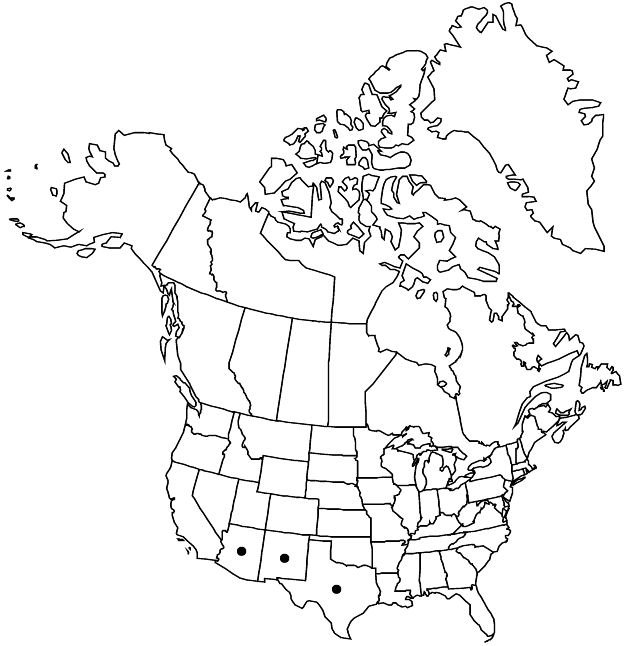Difference between revisions of "Euphorbia chaetocalyx"
Proc. Biol. Soc. Wash. 48: 40. 1935.
FNA>Volume Importer |
RevisionBot (talk | contribs) m (Bot: Adding category Revised Since Print) |
||
| (7 intermediate revisions by 3 users not shown) | |||
| Line 8: | Line 8: | ||
}} | }} | ||
|common_names=Bristlecup sandmat | |common_names=Bristlecup sandmat | ||
| − | |basionyms={{Treatment/ID/ | + | |basionyms={{Treatment/ID/Basionym |
|name=Euphorbia fendleri var. chaetocalyx | |name=Euphorbia fendleri var. chaetocalyx | ||
| − | |authority=Boissier in A. P. de Candolle and A. L. P. P. de Candolle | + | |authority=Boissier |
| + | |rank=variety | ||
| + | |publication_title=in A. P. de Candolle and A. L. P. P. de Candolle, Prodr. | ||
| + | |publication_place=15(2): 39. 1862 | ||
}} | }} | ||
|synonyms={{Treatment/ID/Synonym | |synonyms={{Treatment/ID/Synonym | ||
|name=Chamaesyce chaetocalyx | |name=Chamaesyce chaetocalyx | ||
|authority=(Boissier) Wooton & Standley | |authority=(Boissier) Wooton & Standley | ||
| + | |rank=species | ||
}} | }} | ||
|hierarchy=Euphorbiaceae;Euphorbia;Euphorbia sect. Anisophyllum;Euphorbia chaetocalyx | |hierarchy=Euphorbiaceae;Euphorbia;Euphorbia sect. Anisophyllum;Euphorbia chaetocalyx | ||
| Line 26: | Line 30: | ||
-->{{Treatment/Body | -->{{Treatment/Body | ||
| − | |distribution= | + | |distribution=Ariz.;N.Mex.;Tex.;n Mexico. |
|discussion=<p>Varieties 2 (2 in the flora).</p><!-- | |discussion=<p>Varieties 2 (2 in the flora).</p><!-- | ||
--><p><i>Euphorbia chaetocalyx</i> is similar to <i>E. fendleri</i> but can generally be distinguished from that species by its narrow, acute leaves and ± erect stems. Some authors have used the presence or absence and shape of the involucral gland appendages to help separate <i>E. chaetocalyx</i> from <i>E. fendleri</i>, but those characters appear highly variable and of little taxonomic utility. Some individuals from western Texas (Culberson and El Paso counties) and southern New Mexico appear intermediate with <i>E. fendleri</i>. The specific epithet of <i>E. chaetocalyx</i> refers to the bristly perianthlike segments that subtend the ovary, but these structures are found intermittently in both <i>E. chaetocalyx</i> and <i>E. fendleri</i>.</p> | --><p><i>Euphorbia chaetocalyx</i> is similar to <i>E. fendleri</i> but can generally be distinguished from that species by its narrow, acute leaves and ± erect stems. Some authors have used the presence or absence and shape of the involucral gland appendages to help separate <i>E. chaetocalyx</i> from <i>E. fendleri</i>, but those characters appear highly variable and of little taxonomic utility. Some individuals from western Texas (Culberson and El Paso counties) and southern New Mexico appear intermediate with <i>E. fendleri</i>. The specific epithet of <i>E. chaetocalyx</i> refers to the bristly perianthlike segments that subtend the ovary, but these structures are found intermittently in both <i>E. chaetocalyx</i> and <i>E. fendleri</i>.</p> | ||
| Line 51: | Line 55: | ||
-->{{#Taxon: | -->{{#Taxon: | ||
name=Euphorbia chaetocalyx | name=Euphorbia chaetocalyx | ||
| − | |||
|authority=(Boissier) Tidestrom | |authority=(Boissier) Tidestrom | ||
|rank=species | |rank=species | ||
| Line 58: | Line 61: | ||
|basionyms=Euphorbia fendleri var. chaetocalyx | |basionyms=Euphorbia fendleri var. chaetocalyx | ||
|family=Euphorbiaceae | |family=Euphorbiaceae | ||
| − | |distribution= | + | |distribution=Ariz.;N.Mex.;Tex.;n Mexico. |
|reference=None | |reference=None | ||
|publication title=Proc. Biol. Soc. Wash. | |publication title=Proc. Biol. Soc. Wash. | ||
|publication year=1935 | |publication year=1935 | ||
|special status= | |special status= | ||
| − | |source xml=https:// | + | |source xml=https://bitbucket.org/aafc-mbb/fna-data-curation/src/2e0870ddd59836b60bcf96646a41e87ea5a5943a/coarse_grained_fna_xml/V12/V12_102.xml |
|genus=Euphorbia | |genus=Euphorbia | ||
|section=Euphorbia sect. Anisophyllum | |section=Euphorbia sect. Anisophyllum | ||
| Line 69: | Line 72: | ||
}}<!-- | }}<!-- | ||
| − | -->[[Category:Treatment]][[Category:Euphorbia sect. Anisophyllum]] | + | --> |
| + | |||
| + | [[Category:Treatment]] | ||
| + | [[Category:Euphorbia sect. Anisophyllum]] | ||
| + | [[Category:Revised Since Print]] | ||
Latest revision as of 18:10, 6 November 2020
Herbs, perennial, with woody, thickened taproot. Stems usually erect, rarely slightly decumbent, often densely clustered from top of woody crown, 3–15 cm, glabrous. Leaves opposite; stipules distinct, narrowly linear, usually entire, 0.5–1 mm, glabrous; petiole 0.5–1 mm, glabrous; blade ovate to lanceolate or oblong- or linear-lanceolate, 3–11 × 0.8–3(–5) mm, base slightly asymmetric, short-tapered, occasionally one side slightly rounded, margins entire, apex acute or short-acuminate, surfaces glabrous; only midvein conspicuous. Cyathia solitary at distal nodes; peduncle 0.8–1.3 mm. Involucre campanulate to turbinate, 0.8–1.4 × 0.8–1 mm, glabrous; glands 4, yellow-brown to reddish, concave or convex, elliptic or oval, 0.2–0.4 × 0.4–0.6 mm; appendages absent or white, lanceolate-deltate to straplike, 0.2–1.1 × 0.2–0.9 mm, distal margin entire, crenate, or deeply cleft or divided. Staminate flowers 25–35. Pistillate flowers: ovary glabrous; styles 0.3–0.4 mm, 2-fid 1/2 length. Capsules depressed-ovoid to depressed-globose, 1.7–2.1 × 1.6–2.4 mm, glabrous; columella 1.2–1.8 mm. Seeds white, ovoid-pyramidal, prominently 4-angled in cross section, 1.6–2 × 1–1.2 mm, smooth to slightly wrinkled.
Distribution

Ariz., N.Mex., Tex., n Mexico.
Discussion
Varieties 2 (2 in the flora).
Euphorbia chaetocalyx is similar to E. fendleri but can generally be distinguished from that species by its narrow, acute leaves and ± erect stems. Some authors have used the presence or absence and shape of the involucral gland appendages to help separate E. chaetocalyx from E. fendleri, but those characters appear highly variable and of little taxonomic utility. Some individuals from western Texas (Culberson and El Paso counties) and southern New Mexico appear intermediate with E. fendleri. The specific epithet of E. chaetocalyx refers to the bristly perianthlike segments that subtend the ovary, but these structures are found intermittently in both E. chaetocalyx and E. fendleri.
Selected References
None.
Key
| 1 | Leaf blades ovate to lanceolate or oblong- or linear-lanceolate; involucral gland appendages absent or lanceolate-deltate, entire, crenate, or deeply cleft; widely distributed in Arizona, New Mexico, w Texas. | Euphorbia chaetocalyx var. chaetocalyx |
| 1 | Leaf blades narrowly-ovate to linear-lanceolate; involucral gland appendages straplike, divided into 3–5 linear segments; cliffs and rocks of Boquillas Canyon, sw Texas. | Euphorbia chaetocalyx var. triligulata |